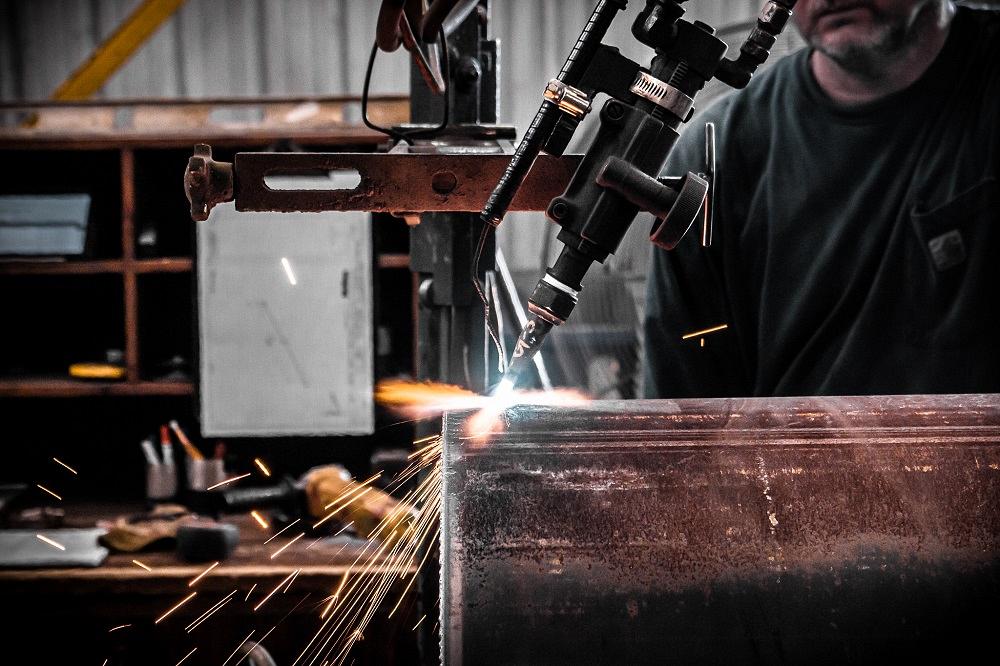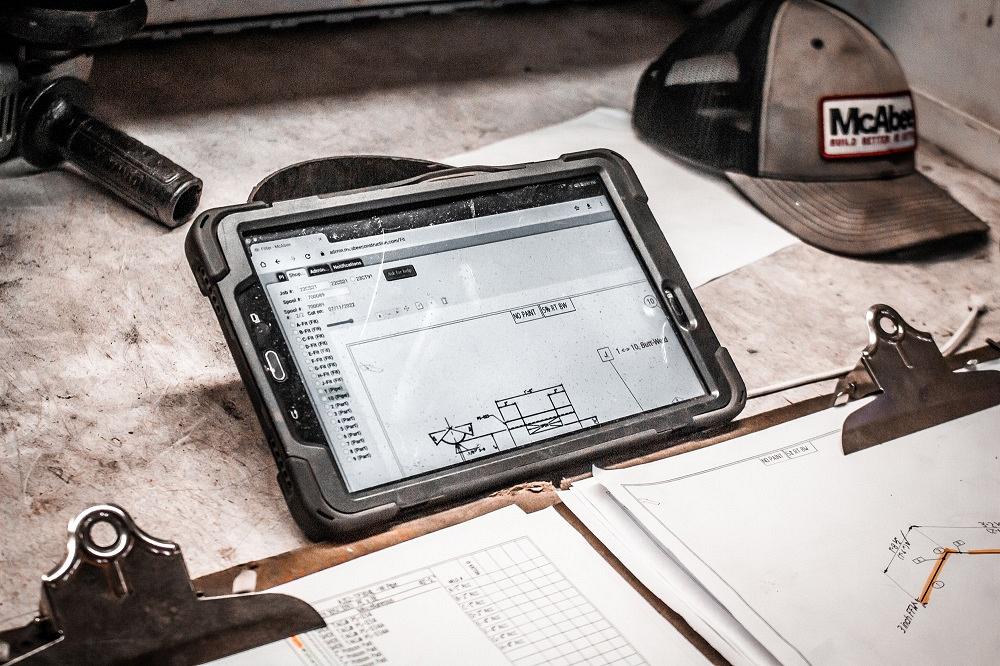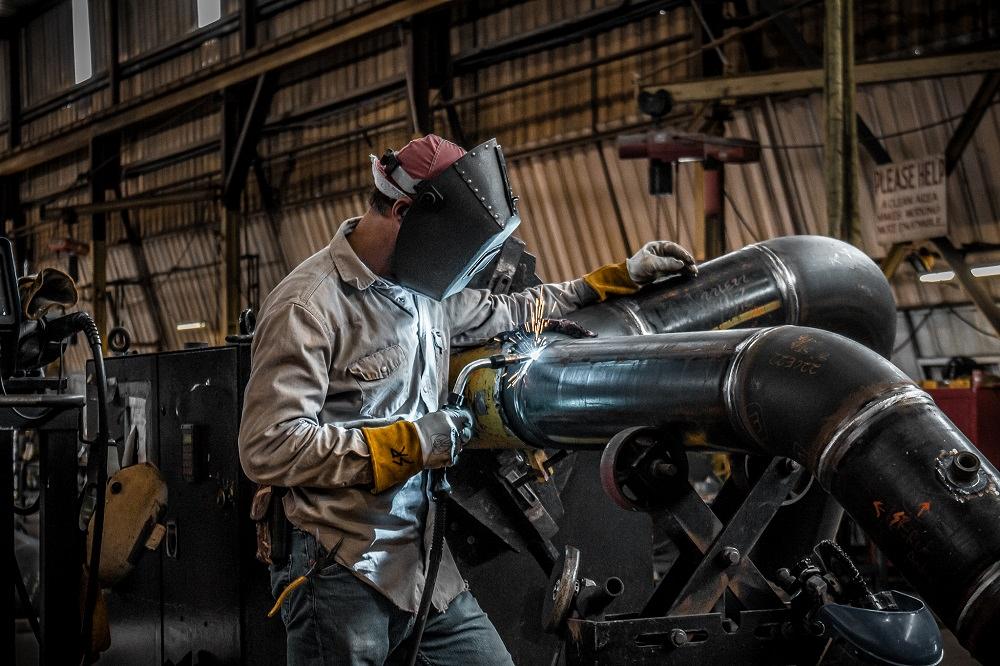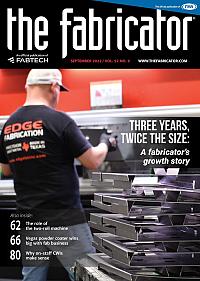Senior Editor
- FMA
- The Fabricator
- FABTECH
- Canadian Metalworking
Categories
- Additive Manufacturing
- Aluminum Welding
- Arc Welding
- Assembly and Joining
- Automation and Robotics
- Bending and Forming
- Consumables
- Cutting and Weld Prep
- Electric Vehicles
- En Español
- Finishing
- Hydroforming
- Laser Cutting
- Laser Welding
- Machining
- Manufacturing Software
- Materials Handling
- Metals/Materials
- Oxyfuel Cutting
- Plasma Cutting
- Power Tools
- Punching and Other Holemaking
- Roll Forming
- Safety
- Sawing
- Shearing
- Shop Management
- Testing and Measuring
- Tube and Pipe Fabrication
- Tube and Pipe Production
- Waterjet Cutting
Industry Directory
Webcasts
Podcasts
FAB 40
Advertise
Subscribe
Account Login
Search
How a pipe spool fabricator digitized traceability for welders
Alabama-based industrial contractor McAbee modernizes the job traveler
- By Tim Heston
- September 20, 2022
- Article
- Tube and Pipe Fabrication
Code-level pipe welding is about traceability: who did what, when, with what process and which consumable, as dictated by this welding procedure specification (WPS) qualified to be used for that pipe spool, and for which this welder is qualified to perform. Without good project management, it can all snowball into a paperwork nightmare.
By the early 2010s, the leaders at McAbee, an industrial contractor and pipe spool fabricator in Tuscaloosa, Ala., saw the issue as more than a paperwork problem. It sapped efficiency and forced talented, well-paid people to spend too much of their day walking the length of McAbee’s 144,000-sq.-ft. floor to report problems or ask for clarifications. The problem could be a fitting error, or perhaps just trying to read bad handwriting on a job traveler. Is this a B or an 8? Sometimes they simply wanted to know if they could pull material for a specific job.
Today, the shop superintendent receives a text on his smartphone. Material is ready to be pulled and cut. Job travelers still exist; pipe welders still find it easier to be able to pull out and unfold a large print. But the web of paperwork to ensure traceability—from material test reports (MTRs) and WPSs to procedure qualification records and welder continuity documentation tied to those client-approved WPSs—now resides on a web-based system that the fabricator designed and wrote in-house. It’s called MATS, the McAbee Automated Tracking System, and it’s changed the way the pipe spool fabricator does business.
Material Tracking Origins
“MATS really started as a material tracking software. We realized we needed to get away from the paper version of filing all those MTRs, then coming back to the paperwork at a later date to assemble the turnover package [a collection of paper binders handed over to the client]. And we really saw the need to have a real-time proactive approach to making sure that the correct spool was being fabricated, and that we had all the documentation accessible to the client ... The foundation [of MATS] is in material traceability, but its tentacles grew to a lot of different facets of fabrication.”
That was Patrick Swann, the company’s director of fabrication, who described MATS’ current state as a “digital web of nodes interlinked with relevant information.”
The software’s origins go back to 2012. As Swann explained, at that time the company couldn’t find an off-the-shelf software option that could meet its needs. “Besides, we didn’t want to change our workflow to match the requirements of an off-the-shelf program. Instead, we wanted something that married with our current workflow.”
The Current State
MATS has come a long way over the past several years. “Today, at any moment, we can pull up an MTR on any piece of material in the shop,” Swann explained. “From the minute the material hits our yard and from our initial purchase orders all the way through to when the final spool leaves the shop, we have 100% traceability.”
Being an ASME-accredited pressure piping and pressure vessel manufacturer as well as an ASME Nuclear Quality Assurance (NQA 1) compliant operation, McAbee relies on MTRs that certify a material is what it’s supposed to be. “Visually, you can’t tell the difference between, say, P91 and carbon steel,” Swann said. “The same goes for stainless steel; 316 looks like 321, which looks like 347.”
It all starts with the receiving operation. As material is received, the heat numbers, MTRs, and material measurements (like diameter and wall thickness) are entered into MATS, and the “nodes” of connected data points start to build.
From here, the scheduler implements a “release to shop,” basically a list of all pipe-spool jobs grouped by due date and pipe diameter. “Just from an efficiency standpoint, we tend to release like-sized spools to the shop at once,” Swann said. “We’re a very high-mix operation, but pipe diameters give us that common denominator so we can optimize workflow.”

A pipe is bevel-cut in preparation for welding. In the background, a tablet showing a digital scan of the drawing runs the company’s MATS platform.
MATS sends a pull list to the material handler, who begins staging pipe and fittings for a certain job, complete with the heat numbers and any MTRs associated with a certain component. Staged material is recorded in MATS, which in turn triggers a text message to be sent to the shop foreman and superintendent.
The pipe gets cut to length, after which the pieces and fittings are staged at the front of the weld shop. Another node goes into MATS—material is ready for fitting. Fitters retrieve the material and prep it for welding, tacking where necessary.
“The software helps us be proactive here,” Swann said. “Before the fitters tack pieces together, they know those pieces are valid, because the software confirms the heat number against the description on the engineering drawing.”
The fitter confirms the material is correct, records that it has been tacked with a specific consumable wire, and posts that the job is ready for welding. At this point, the nodes within MATS really start to build. Besides the job status and “ready for welding” timestamp, data points include the material certification, consumable material certification including the wire grade and diameter, which in turn are approved to be used with the client-approved WPS.
Consumables records are one of MATS’ more recent additions. The software keeps records on them just as they would any other material, ensuring that the diameter and chemical makeup are qualified per the WPS. Moreover, MATS details every WPS that’s been approved for specific jobs—and some might have more than one.
For instance, a certain pipe spool job might call for root passes that can be performed with either gas tungsten arc welding (GTAW, or TIG) or the regulated metal deposition (RMD) variant of gas metal arc welding. “If a welder has RMD and TIG available, he’ll probably pick the fastest approach, so he’ll likely pick RMD.” And he has that available to him in MATS. The project manager has already identified weld processes for the job and submitted them to the client for approval. The process selection then goes into MATS—another node in the process traceability web.
Welder Qualification and Continuity
MATS records every weld a welder makes and every WPS a welder follows to make them. This includes a shop’s permanent welders, as well as any welder the operation might hire temporarily from the union hall. Uploading that welder’s continuity records to MATS has become part of the onboarding process.
“Every time the welder makes a weld, we extend his continuity,” Swann said. “If the welder is dormant for a time, or for whatever reason is no longer making welds, we have the system set up to notify the quality director, quality lead, and shop superintendent.
“When a welder logs into MATS, it will show which WPSs he can weld on,” Swann continued. “If he’s out of continuity, it doesn’t give him an option to select that WPS, so he’s basically a fish out of water and can’t do anything. So, he has to inform his foreman and superintendent, at which point he’d do another test to requalify.”
That said, the shop has numerous proactive notifications to ensure this rarely happens. They start 30 days from the date when the welder would be out of continuity and need to be requalified with a welder performance qualification (WPQ). The system sends notifications once a week, then every day during the last week.

MATS complements, but does not eliminate, the paper traveler. Many part drawings are just easier to view on paper. That said, the most up-to-date, complete information about the job is always in a digital format.
NDE and Client Transparency
When the pipe spool arrives at nondestructive examination (NDE), the quality technicians pull up the requirements in MATS. The job could call for a hydro test, magnetic particle test, radiography, positive material identification, or any combination. The tech performs the test, then uploads the results to MATS. If the results don’t meet requirements, MATS creates a nonconformance report (NCR). From here, the data aggregation begins as techs uncover the root causes.
Errors are rare, and they’re usually related to performance issues, not logistical ones. MATS helps ensure that fitters and welders have the correct material, the right WPS, and the right material certifications. The issue might have to do with a bad weld or perhaps an orientation error made by a fitter. Whatever it is, “the system allows us to identify errors and correct them early, before the issue runs away from us,” Swann said.
“The system isn’t happy until the inspection report satisfies the requirements,” Swann continued, adding that results can be audited, either shortly after the results are uploaded to the system or at the end of a job in a digital turnover package—much more efficient than the collection of binders McAbee used to turn over to clients.
Clients can log on to MATS not just to see NDE results, but also to check on a job’s progress. Like checking on a UPS package being delivered, they can log on to see what stage of production the pipe spool is in now, where it has been, and where it’s going, along with all the supporting documentation connected to it.
Next Steps
Since being implemented over the past seven years, MATS’ tentacles have spread throughout the shop floor. The next step, Swann said, is bringing it to McAbee’s field operations. Implementation is progressing gradually as managers work through “connecting all the dots,” as Swann put it. “We need to make sure we have the correct purchase orders in the system, the material receipts, and many other factors.” He added that the company is “taking the easy steps first,” implementing digital weld logs on certain field projects, but he added the rollout will continue over the ensuing months.
Swann referred to MATS as a kind of never-ending improvement project. All those connected nodes of data points reveal efficiencies, strengths, and weaknesses. They streamline traceability and make overall workflow more transparent.
Swann added that conceptually, MATS doesn’t really alter the existing quality systems for ASME-certified pipe welding operations. Every spool has welds connected to a WPS, which is connected to a welder’s WPQ, all connected to MTRs to certify a material is what it’s supposed to be.
“Essentially, we’ve taken the traceability of the paper traveler and made it digital,” Swann said, “so that every BOM [bill of material] item on a spool is traceable to a spool number, the ISO number [for a particular pipe], and the job number.”
Code-level welders might spend their days swimming in an alphabet soup—WPS, WPQ, MTR, NCR—but all those initialisms serve an important purpose. McAbee’s MATS platform just ensures they don’t spend their days walking to and from the office with paper travelers in hand, checking to see whether a B is really a B or an 8.
About the Author

Tim Heston
2135 Point Blvd
Elgin, IL 60123
815-381-1314
Tim Heston, The Fabricator's senior editor, has covered the metal fabrication industry since 1998, starting his career at the American Welding Society's Welding Journal. Since then he has covered the full range of metal fabrication processes, from stamping, bending, and cutting to grinding and polishing. He joined The Fabricator's staff in October 2007.
subscribe now

The Fabricator is North America's leading magazine for the metal forming and fabricating industry. The magazine delivers the news, technical articles, and case histories that enable fabricators to do their jobs more efficiently. The Fabricator has served the industry since 1970.
start your free subscription- Stay connected from anywhere

Easily access valuable industry resources now with full access to the digital edition of The Fabricator.

Easily access valuable industry resources now with full access to the digital edition of The Welder.

Easily access valuable industry resources now with full access to the digital edition of The Tube and Pipe Journal.
- Podcasting
- Podcast:
- The Fabricator Podcast
- Published:
- 04/16/2024
- Running Time:
- 63:29
In this episode of The Fabricator Podcast, Caleb Chamberlain, co-founder and CEO of OSH Cut, discusses his company’s...
- Industry Events
16th Annual Safety Conference
- April 30 - May 1, 2024
- Elgin,
Pipe and Tube Conference
- May 21 - 22, 2024
- Omaha, NE
World-Class Roll Forming Workshop
- June 5 - 6, 2024
- Louisville, KY
Advanced Laser Application Workshop
- June 25 - 27, 2024
- Novi, MI

































